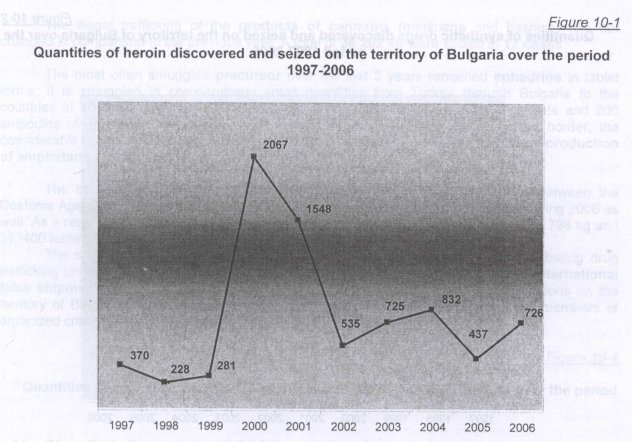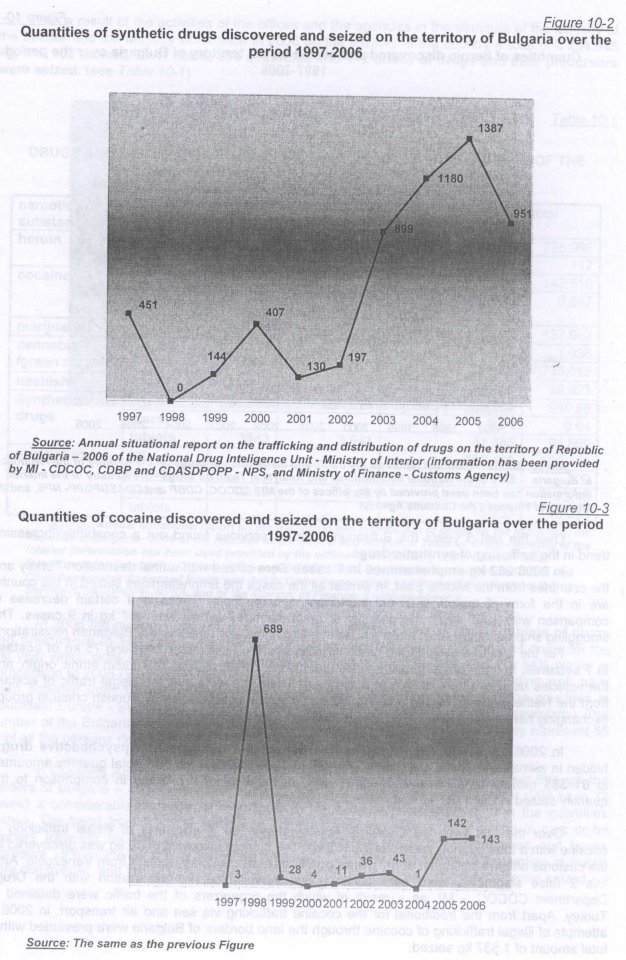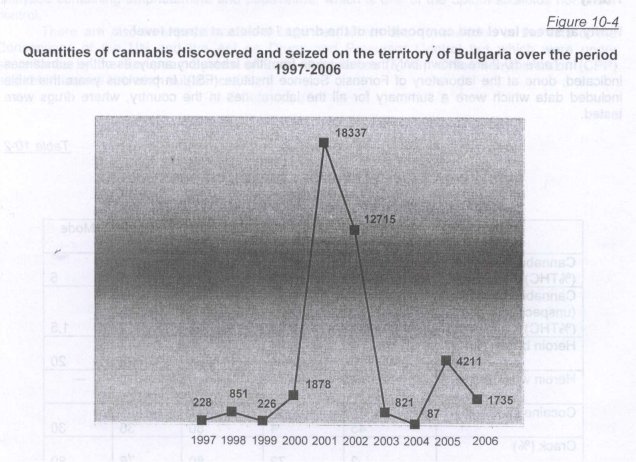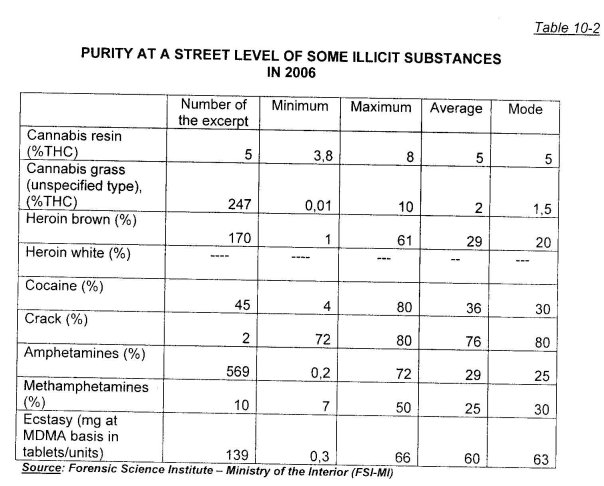10. Drug Markets
| Reports - Annual Report Bulgaria |
Drug Abuse
10. Drug Markets
Within the frames of this section the following main topics will be reviewed:
Availability and supply;
Seizures of drugs;
Price and purity of drugs at street level.
On reviewing the topic of drug availability and the ways to supply drugs attenyon has been focused on the information and data related to drug availability among the population as a whole, among students at universities and among prisoners as representing specific social groups, as well as on the production, the sources for supply and models of trafficking drugs in the country and abroad. The different routes registered and ways of production are indicated — as a whole and for the different types of drugs. When reviewing these issues information from the Ministry of the Interior has mainly been used, and also information provided by the Customs Agency at the Ministry of Finance. Different studies conducted by the National Focal Point on Drugs and Drug Addictions have been used as a source of information, too — mainly in relation to drug availability.
The number of seizures and the quantity of drugs seized have been the main point when analyzing the second topic in the section, and attention has been focused on the main trend as well as on the data about the specific drugs and in some cases about the different institutions. Information provided by the Ministry of the Interior and by the Customs Agency at the Ministry of Finance has mainly been used.
In this report the topic of the price and purity of drugs at street level is presentedby giving information on the price at street level (on the data from two sources - the police and the local regional institutions) as well as by presenting information on the purity at street level and the purity of drugs / tablets — according to types of drugs. On reviewing these topics information and analyses were used presented by the Chief Directorate of the National Police Service IN PSI, by the regional boards on drugs and by the Scientific and Research Institute of Criminology.
Availability and Supply
Production, sources of supply and models of trafficking inside the country and abroad
In 2006 the trends observed in the previous years still held. Through the territory of Bulgaria heroin, synthetic drugs, cannabis and cocaine were transported. As a characteristic peculiarity stands out the fact that a large part of the illicit drugs are only transited through the territory of the country and just a small part of them are kept for the local market.
Afghanistan is still the main leader in the production and supply of opium, which is the main raw material for the production of heroin. The heroin used in the countries of the European Union comes mainly from Afghanistan, Turkey and Iran. The trend also holds of dislocating the traditionally used routes of trafficking from Turkey through the Balkans along roundabout routes (to the North through the Caucasian region and to the South by the Mediterranean). The reason for this dislocation is on the one hand the inadequate borderline control in the countries from the Caucasian region and on the other hand-the successful activity of the law-enforcing bodies in Bulgaria and the redistribution of the drug markets done by the organized criminal groups. In spite of this the smuggling of heroin from the processing centers via the confirmed Balkan routes to the drug markets in Western Europe is still a fact.
The organizers of the channel for heroin trafficking are mainly Turkish citizens and citizens of ex-Yugoslavia - ethnic Albanians from Kosovo.
The analysis of the information available about the market of heroin at national, regional and global level delineates two main trends: demand exceeds supply and respectively the prices of this illicit drug are constantly dropping. An illustrative example of these trends is the glutting of the UK market where from the middle of 2003 around 25-35 tons of heroin of ever increasing purity are smuggled annually, and meanwhile the price of 70 pounds for a gram of heroin in December 2000 dropped to 54 pounds in December 2005. In general, over the period 2000-2005 the drop in the prices of heroin was 45 °A for all the European countries. Bulgaria is not an exception in relation to all the European and global trends — for the last 6 years the number of heroin users remained relatively constant (20 000-30 000), but there was a drug abuse reduction and a drop in the prices in the different regions of the country was observed.
Traditionally cannabis remains the most widely used and produced drug globally in all of its forms: marijuana, green mass, resin, hashish and oil. The cannabis offered for use in the European Union comes from different countries — the Netherlands, Albania, the USA and from a number of African countries. In most of the countries there is local growing — in green houses or in the open. It is also the drug to be most often seized in the European Union and it comes second to heroin as a cause for treatment demand.
In 2006 in Bulgaria cannabis continued to be the most widely used drug. There are no significant changes observed in its growing and distribution over the territory of the whole country. The trend still holds of supplying the home market from the plantations in the hard — to - reach and uncultivated lands mainly in the regions of Petrich, Sandanski and Ograzhden. There have been attempts of growing it in green houses in the towns. Because of its higher price in Greece compared to the price in Bulgaria part of the amount produced is smuggled through the so called "green border" and through the state border check points. Channels for smuggling are used which have been established along the Balkan route.
Next to cannabis the most widely used illicit drugs in the countries from the European Union are the synthetic drugs. According to the report of the UN for 2005 Bulgaria produces 3 % of the world production of amphetamines. The active traffic of kaptagon is intended mainly for Turkey, Syria, Jordan and Saudi Arabia. In respect to quality, however, the synthetic drugs produced in Bulgaria are inferior to those produced in the European countries and are of lower price.
The processes of popularizing and expanding the synthetic drug market are characteristic of Bulgaria, too. The number of young people using amphetamines and ecstasy (especially in the capital and in the large towns with a population over 100 000 people) is also increasing.
Cocaine comes third in the trafficking of drugs worldwide. The production of cocaine on a global level is growing. The main countries producers of this illicit drug are Columbia (56 % of the total production), Peru (28 %) and Bolivia (16 %). Over the last 5 years the quantities of cocaine seized in the countries from the EU are on the increase. According to a report by the UN, the annual profit from cocaine trade amounts to 300 000 000 €. The experts in the field point London as the world capital of cocaine, where the demand for cocaine is larger than that for ecstasy.
In 2006 some characteristic for the previous years trends in the trafficking and distribution of cocaine still held — the participation of Bulgarian citizens in organized criminal groups trafficking cocaine from South America to countries in Central and Western Europe. Under the cover of legal trade activity smuggling of larger quantities of cocaine is done- transported by sea, and of smaller quantites — by air.
Bulgaria is most often transit country — cocaine has as a final destination other countries in Europe. The distribution of cocaine in the country is limited because of its high market price.
Seizures
In 2006 the counteracting to the traffic and distribution of drugs on the territory of the Republic of Bulgaria remained a priority in the activity of all the law-enforcing institutions responsible for this. The specialized offices at the Ministry of the Interior are the main factor in respect to reducing the supply, they are a partner in reducing the demand and use of drugs and from them originated the initiatives to change the legislation in respect to the different aspects of the problem.
As a result of the activities of the offices and the agencies in the structure of the Ministry of the Interior and the Ministry of Finance in 2006 on the territory of the country a total of 4 234 545 kg, 110 102 tablets, 73.47 liters, 200 ampoules and 112 doses of drugs and their precursors were seized. (see Table 10-1).

In 2006 the customs officers seized a total of 1 459.895 kg and 96 618 tablets of drugs and precursors in 148 cases. The number of the attempts for illegal trafficking of drugs for the last year which were solved by the Customs Agencies is record breaking and it is 54% higher in comparison to 2005 (96 cases with a total of 1 137.630 kg seized). A total of 100 delinquents have been arrested from 12 different nationalities and 88% of them are citizens of the countries in Southeast Europe - Bulgarians, Serbians, Turks, Macedonians, Slovenians, and Romanians). The number of the Bulgarian traffickers is growing continuously, and for the last year they represent 55 % of all the persons detained.
In Customs Agency in 2006 heroin was again the drug smuggled most often through the borders of Bulgaria - 493 kg in 48 seizures. When compared to the previous year (324 kg in 32 cases) a considerable increase is seen, both in the number of seizures, and in the quantities seized. The trend from 2005 of smuggling comparatively low quantities of heroin in cars or by couriers traveling by bus still held in 2006. The seizures from cars, microbuses and buses represent 75% of the total number of the seizures. Last year 4 attempts of smuggling in trucks were discovered, and the 185 kg seized then amount to 1/3 of the total quantity of heroin seized.
Source: Annual situational report on the traffic and distribution of drugs on the territory of the Republic of Bulgaria - 2006 of the National Informational and Analytical Team on Drugs - the Ministry of the Interior (information has been used provided by the offices of the Ml- CDCOC, CDBP and CDASDPOPP- NPS, and the Ministry of Finance, the Customs Agency)
Over the last 5 years the Bulgarian customs services found out a constantly increasing trend in the trafficking of synthetic drugs.
In 2006 282 kg amphetamines in 7 cases were seized with a final destination-Turkey and the countries from the Middle East. In almost all the cases the amphetamines seized in the country are in the form of tablets with the kaptagon logo on them. There is a certain decrease in comparison with 2005 when the quantity of amphetamines seized was 407 kg in 9 cases. The smuggling shipments are most often hidden in microbuses and buses under Bulgarian registration.
For the first time in 2006 the customs officers seized the record breaking 75 kg of ecstasy in 7 seizures. In most of the cases the delinquents are Dutch citizens of Turkish ethnic origin, and the vehicles used are cars of Dutch registration. There are data that the illegal traffic of ecstasy from the Netherlands to Turkey passing through Bulgaria is organized by Turkish criminal groups exchanging heroin for ecstasy.
In 2006 there was a great increase in the number of seizures of psychoactive drugs, hidden in airmail and postal shipments, from 20 to 1000 tablets each. The total quantity amounted to 81 385 tablets in 39 cases, which means an increase of 2.7 times in comparison to the quantity seized in 2005 (30 168 tablets in 25 seizures).
Over the last year the Customs Agency prevented 7 attempts of illegal trafficking of cocaine with a total quantity seized of 63.333 kg. The biggest shipment of 60 kg was discovered by the customs officers in August at the Varna port in a naval container coming from Venezuela. After this 2 false shipments were sent under police surveillance, in cooperation with the Drugs Department CDCOC - MI, as a result of which the organizers of the traffic were detained in Turkey. Apart from the traditional for the cocaine trafficking via sea and air transport, in 2006 4 attempts of illegal trafficking of cocaine through the land borders of Bulgaria were prevented with a total amount of 1.537 kg seized.
The illegal trafficking of the products of cannabis (marijuana and hashish) has not changed in comparison to the previous year. A total of 36.202 kg were seized in 13 cases.
The most often smuggled precursor over the last 3 years remained ephedrine in tablet forms. It is smuggled in comparatively small quantities from Turkey through Bulgaria to the countries in Western Europe. In 2006 in 7 cases a total of 9.430 kg, 15, 233 tablets and 200 ampoules of ephedrine were seized. For the first time, on crossing the Bulgarian border, the considerable quantity of 500 kg phenylacetic acid (a precursor, used for the illegal production of amphetamine) was seized.
The traditionally good professional contacts and exchange of information between the Customs Agency and the specialized offices of the Ministry of the Interior continued during 2006 as well. As a result of the joint activities of the customs and the police bodies a total of 33.798 kg and 35, 400 tablets of drugs and 500 kg of precursors were seized in 15 cases.
The specialized teams of the Customs Agency and the CDC0C-MI for combating drug trafficking under the guidance of the Supreme Prosecutor's Cassation organized 6 international false shipments (under police surveillance) of drugs. As a result of these operations on the territory of Bulgaria and abroad more than 160 kg of drugs were seized and the members of organized criminal groups who did the trafficking were arrested.

Source: Annual situational report on the traffic and distribution of drugs on the territory of the republic of Bulgaria - 2006 and of the national Informational and Analytical Team on Drugs - the Ministry of the Interior (information has been used provided by the services of the Ministry of the Interior - CDCOC, CDBP and CDASDPOPP- NPS, and by the Ministry of Finance - the Customs Agency)
For the last year the Customs Agency participated actively in 5 international operations to counteract the illegal trafficking of drugs, precursors, weapons and explosives. 4 of the operations were carried out on the initiative of the customs cooperation Work Group under the European Committee, namely:
• "COMPASS" operation — against the illegal trafficking of cocaine in naval containers and container-tractors coming from Latin America and South Africa to Europe;
• "PALLAS" operation — against the smuggling by land transport of precursors for the production of synthetic drugs;
• "FIREBALL" operation — against the illegal trade with weapons and explosives, transported by land from other countries to countries-members of the European Union;
• "CONQUEST 2" operation — against the illegal traffic of heroin in naval containers coming to Europe from Afghanistan, Pakistan, India, Bangladesh, Iran and Oman.
In July 2006 the anti-drug departments at the Customs Agency and CDCOC took part in the "PREVENTION 5" international operation for combating heroin smuggling along the Balkan route in road vehicles. The decision to carry out this operation was made by the Specialized Work Group on Drugs at the Initiative for Cooperation in Southeast Europe (ICSEE) Center in Bucharest and in it participated the members of 12 customs and police administrations from Central and Southeast Europe. Within the frames of the operation the Bulgarian customs officers prevented a total of 9 attempts of smuggling, including 35 kg of ecstasy in 2 cases, 9.270 kg of heroin, 30 000 €, 1,654,000 pieces of cigarettes, 121 antique coins and other articles for smuggling. After the end of the operation, the ICSEE Center in Bucharest officially announced that Bulgaria, with these results, ranks first among the countries — participants.
Purity
Purity at street level and composition of the drugs / tablets at street level
In Table 10-2 are shown only the data taken from the laboratory analyses of the substances indicated, done at the laboratory of Forensic Science Institute (FSI). In previous years this table included data which were a summary for all the laboratories in the country, where drugs were tested.

The data shown in table 14 and table 15, for 2005 and 2006 are from the data basis of the "Drugs" sector at FSI-Ml. The data for the synthetic drugs are for the whole country because these substances are only tested at the laboratory of the FSI, while the substances heroin, cocaine, cannabis and hashish are analyzed at 12 other regional laboratories in the whole country.
Because in table 14 there are no separate rows for the content of amphetamine in the powder and in the tablets, the content of amphetamine is shown in the table irrespective of the different forms. This is not quite correct, because the content of amphetamine in the powder and in the tablets is very different.
In 2006 there was observed an increase in the number of the samples containing heroin and cocaine, while those for cannabis were less (for the laboratory of the FSI). Likewise the increased number of tablets containing MDMA should also be considered. This increase is at the expense of the amphetamine-containing tablets. The number of tablets containing more than one psychoactive substance has also increased. For example the number of tablets analyzed containing apart from MDMA also chlorphenylpiperazin (CPP), MDEA, amphetamine and N-ethyl MDA has increased. This trend, of mixing more than one narcotic substance, is also observed in the powdered drugs, where there are cases of mixing an amphetamine with heroin, with codeine, with cocaine and with ketamine.
In samples of amphetamine besides the often present additional substances like caffeine, procaine, chinin, pyramem, benzocaine, theophyline, paracetamol, in 2006 there were samples analyzed containing amphetamine and papaveirne, which is one of the opium alkaloids not under control.
There are also new psychoactive substances, which are not included in the lists of the Conventions of the UN and the Act on Drugs and Precursor Control but which were under surveillance by the European System of Early Surveillance (EWS). Chlorphenylpiperazin (CPP) and ketamine are two such substances.
| < Prev | Next > |
|---|












